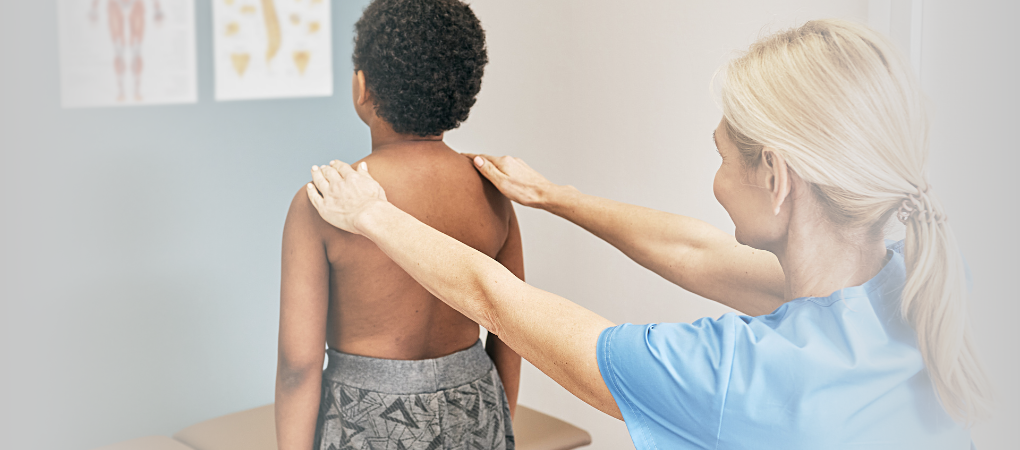Francesca Galiano
|
20/09/2022 - Last update 28/12/2022
Riccardo A. Freely, Holly E. Kapraun | Year 2017
Progressive Infantile Scoliosis Managed With Osteopathic Manipulative Treatment
Pathology:
Scoliosis
Type of study:
Case report
Date of publication of the study’:
2017/Sep/01

Purpose of the study
- Objective: to report the effect of OMT in a female infant with progressive infantile idiopathic scoliosis
- Measured outcomes: rib-vertebral angle difference (RVAD) and report of the symptoms
Participants
- Number: 1
- Description: the infant was born by uncomplicated cesarean delivery, with a weight of 2.8 kg and a length of 50 cm, Apgar scores of 8 and 9 at 1 and 5 minutes.
The mother noted an abnormality in the thoracolumbar curve when the baby was 6 months old, taking under consideration that both the mother and the grandmother had had a mild and non symptomatic idiopathic scoliosis, the brother had a non progressive scoliosis and the father had short-leg syndrome. At 12 months some pediatric orthopedic specialists noted a thoracic deformity with a 46.9° RVAD, consequently issuing a diagnosis of asymptomatic progressive infantile idiopathic scoliosis. The girl then underwent her first Risser casting at the age of 12 months under general anesthesia. She also began to wear a Risser cast from T1 to L5. At 14 months, the RVAD had progressed to 50° and the doctors proceeded with a second Risser casting.
After this intervention the infant was taken to an osteopathic clinic, although she did not present scoliosis-related symptoms.
The structural osteopathic examination highlighted a diminished cranial rhythmic impulse, an alteration in the rotation of temporal bones, C1, sacrum and pelvis. These signs led to a diagnosis of progressive infantile idiopathic plagiocephaly and scoliosis and somatic dysfunctions to head, cervical spine, sacrum and pelvis.
Interventions and evaluations
- 12 monthly sessions of OMT, from the age of 14 months to the age of 28 months
- and afterwards 6 to 10 annual sessions until the age of 5 years, and less frequent sessions up to the age of 7 years
- OMT personalized based on the somatic dysfunctions detected and applied where possible considering the presence of the cast
- main techniques: primary respiratory method, balanced ligamentous tension, indirect, direct, articulatory techniques and myofascial release
Results
At the age of 17 months the second cast was removed and the RVAD had regressed to 40°.
After the second visit the RVAD regressed to 23° and the patient underwent a third casting, but this was removed shortly after due to two episodes of respiratory distress secondary to pneumonia.
After the third visit, the parents decided not to use Risser casting anymore. Moreover, although the use of thoracolumbosacral orthosis brace was advised the parents were noncompliant. Although she was involved in a car accident and did not walk for a day as a result of it, the RVAD continued to drop, down to 12° when she was 21 months old, which was the period of her fifth osteopathic examination.
At each subsequent visit, the child was evaluated and treated on the basis of the findings of the osteopathic assessment.
At 28 months the X-rays showed no signs of scoliosis and up until she was 7 years old the annual X-rays continued to show a stable thoracic curve with a RVAD of less than 5°.
Discussion
In this case, OMT showed the potential to resolve a progressive infantile idiopathic scoliosis through monthly treatments over the first years of age. The reason for this effect may lie in the fact that infantile idiopathic scoliosis is often associated with alterations and asymmetries in cranial development, particularly of the occipital region. Therefore, by working at the cranial level, the OMT may have acted directly on the cause of scoliosis, and not simply on its manifestation as cast would do, thus inducing the body to self-rebalance. This would also explain the positive effect obtained at the first visit where, due to the cast, the thoracolumbar curve was not treated. Given, however, that in the first 4 months of treatment, OMT was applied in combination with orthopedic methods, it is difficult to properly assess which intervention had a priority effect, although scoliosis continued to improve when orthopedic interventions were no longer applied.
Due to the progressive nature of infantile idiopathic scoliosis, which manifests especially in women, it is difficult to hypothesize a spontaneous resolution .
The review of Osteopedia
By Marco Chiera
Strengths: particularly impressive result, especially considering the interruption of the orthopedic interventions, which deserve a more in-depth analysis; interesting osteopathic description of the potential causes underlying this type of scoliosis.
Limits: Although the study shows an important result, a single case does not allow us to draw conclusions about the effectiveness of a therapy. We need bigger, more robust studies. In addition, more rigorous and recent studies would also be needed to support the link between cranial asymmetry/alteration and scoliosis as a compensatory mechanism. Furthermore, although the authors exclude the possibility of spontaneous resolution based on the diagnosis of progressive scoliosis, the diagnosis is not necessarily correct. This is important because, in the case of misdiagnosis, more than half of cases with a situation similar to the one described (with attached plagiocephaly) tend to resolve during childhood. One limitation that is not clear whether it is confusion or otherwise is that the authors talked about RVAD, but in the reported X-rays they showed of Cobb’s angle.

Are you an osteopath?
Register and enjoy the membership benefits. Create your public profile and publish your studies. It's free!
Register now
School or training institution?
Register and enjoy the membership benefits. Create your public profile and publish your studies. It's free!
Register now
Do you want to become an osteopath? Are you a student?
Register and enjoy the membership benefits. Create your public profile and publish your studies. It's free!
Register now







